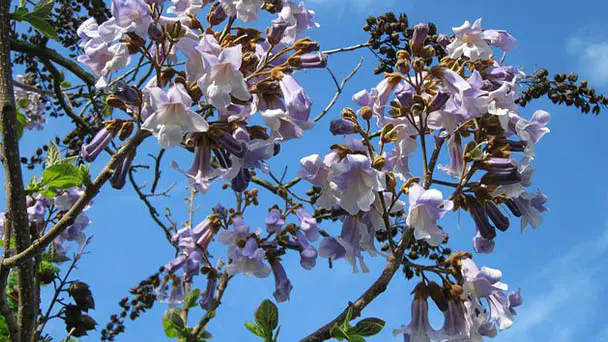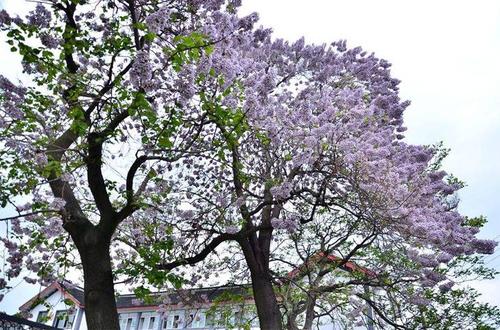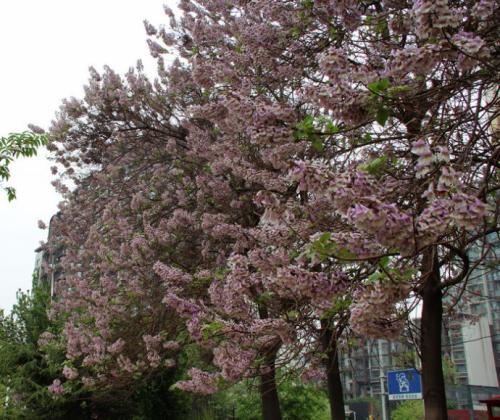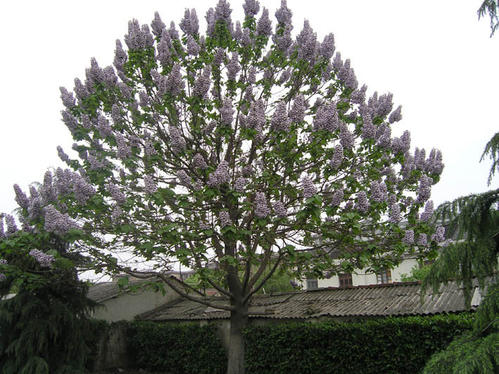Princess tree (Paulownia Tomentosa) profile
Written by Maggie
Nov 09 2021

Princess trees, also known as Empress tree, Paulownia tomentosa, are extremely common, with large leaves and a height of up to about 27 meters, providing excellent shade. Princess tree is a light-loving plant, which is not tolerant to water or shade and is of excellent material, and is mainly made of wood. The leaves, flowers, and wood of a Princess tree have been medically found to have anti-inflammatory, thirsty and diuretic properties.
Princess tree picture

Princess Tree Quick Info
| Botanical/Scientific Name | Paulownia Tomentosa |
| Common Name | Princess tree |
| Uses | It is used for chests, boxes, and clogs |
| Origin | Western and central China |
| Light Care | Full sun |
| Soil Care | Rich, well-drained, acidic soil |
| Temperature Care | Can withstand temperatures as low as -13 °F (-25 °C) |
| Humidity Care | High humidity |
| Watering | Regular watering |
| Pruning Care | Prune to about a third of an inch above a pair of dormant buds |
| Fertilizer Care | Reapply fertilizer in summer and autumn |
| Propagation | Burying roots, seeds |
| Toxic | No toxic effects reported |
| Flower Color | Purple |
Morphological characteristics of Princess tree
Branches: princess trees are deciduous trees, but evergreen in the tropics, crown conical, umbellate or sub cylindrical, bark smooth and marked lenticels when young, divided longitudinally when old.
Leaves: Leaves are opposite, large and long-stalked, sometimes 2-3 whorled on vigorous new branches, heart-shaped to long ovate-heart-shaped, base heart-shaped.
Flowers: The flowers are trumpet-shaped in small cymes with large purple or white corolla.
Fruit: Capsule is ovoid, ovoid elliptic, elliptic or oblong, locularis dehiscent, 2-lobed or incomplete 4-lobed, pericarp thinner or thicker and lignified; Seeds are small and many, membranous wing, with a few endosperm.
Princess Tree Care in Detail
Princess Tree Watering
Generally, the newly bought princess tree should not be watered immediately until the plant adapts to the environment. In daily maintenance, watering is required every day during seedling stage and leaf pumping stage, and the watering times should be reduced after autumn. Water it with rainwater or river water. Tap water can only be poured after drying for several days. Generally, it should be poured at the root, so that it can be better absorbed. If Princess tree needs to change pots or transplant, we need to water it later.
Princess Tree Soil
Princess tree is most suitable for growing in sandy loam or gravel soil with good drainage, deep soil layer and good ventilation. It likes wet and fertile soil, with pH 6 ~ 8 as the best. It has a tendency to selectively absorb elements such as magnesium, calcium and strontium. Princess tree has strong adaptability. It can grow in acidic or alkaline soil, or in barren low mountains, hills or Plains, but it should not accumulate water.
However, Princess tree has strong adaptability and can grow normally even in poor, acidic or alkaline soil environment. Note that it is not resistant to waterlogging. It should be drained in time in the rainy season. Ponding for a long time will hinder growth and the plant is easy to die.
Princess Tree Light
Princess tree needs a lot of light, so we should let it get more sun. It will grow better in the soil environment with good permeability, deep soil layer and good drainage performance.
Princess Tree Temperature
Princess tree likes sunny environment and is more shade resistant. Princess tree has strong drought resistance. We can keep the temperature at - 25 ℃ - 38 ℃ when breeding Princess tree. If the temperature is lower than minus 25 ℃, it will suffer from freezing injury.
Princess Tree Humidity
If we want Princess tree to survive better, we should pay attention to the maintenance methods in the later stage. We should let Princess tree seedlings often bask in the sun. The water demand during seedling growth is also relatively large. Water frequently to make the soil moist. But pay attention to drainage in rainy season, and there shall be no ponding.
Princess Tree Fertilizer
We'd better add an appropriate amount of base fertilizer before the cultivation of Princess tree, and apply accelerated fertilizer from June to August every year to promote faster growth.
Princess Tree Pruning
Princess tree does not need to be pruned during its growth. Only adult plants of five to six years need to be pruned. Princess tree pruning is in early spring. Just cut out the plant type you like. Cutting off the old branches can make it grow more lush.
Princess Tree Repotting
Princess tree seedlings should be repoted in time after they grow up. The best time for Princess tree repotting is in spring. The climate is more suitable, and the seedlings can adapt to the new environment faster and resume growth. Pay attention not to damage the root system as much as possible. Leave the soil mass larger and plant it with the soil mass.
Princess Tree Pest & Disease Control
Anthrax of Princess tree mainly damages the leaves, petioles and young shoots of Princess tree. When Prince tree seedlings grow 1 ~ 2 pairs of true leaves, they begin to develop disease. At the initial stage of leaf damage, the disease spots are spot like that lose green, and then expand into brown and nearly round, surrounded by yellow green, with a diameter of about 1 mm. After rain or when it is wet, pink conidia piles or small black spots are often produced on the disease spots. In the later stage, the diseased spots often rupture and the diseased leaves fall early. Colletotrichum gloeosporioides is caused by the infection of the fungus, which overwinters in the host tissue and becomes the first infection source in the next year, and can be repeatedly infected many times in the growing season. Generally, the disease starts from May to mid and late June, enters the peak period in July, and lasts until August 30. In the growing season of Princess tree seedlings, high temperature and rain, poor drainage, poor ventilation and light transmission, and weak seedling growth are conducive to the occurrence of anthrax. When selecting the seedbed, we should consider the place far away from Princess tree forest.
Princess tree growth environment
Princess tree is a positive species and has strong adaptability to viscous barren soil. They grow very fast and are fast-growing species. It is most suitable for growing in the sandy loam or hard soil with good drainage, deep soil layer and good aeration. It grows well in the mountains, hills, hilly lands and plains below 1200 meters. It’s drought resistance ability is strong, pH 6-8 is better, magnesium, calcium, strontium and other elements have the tendency of selective absorption, so more nitrogen fertilizer increases the application of magnesium, calcium, phosphate fertilizer. Because of its strong adaptability, Princess trees can generally grow in soils with strong acidity or alkalinity, but avoid water accumulation. Princess trees are easy to reproduce, and the method of planting roots and seedlings is more common.

Princess Tree Propagation
Princess tree has a long history of cultivation, the name of the genus.
⑴ Princess Tree Sowing Propagation
The commonly referred to Princess Tree is actually the general name of the genus Princess Tree. There are 9 species in the genus, and the species suitable for growing in the south are Princess Whitefloor or the hybrid species with Princess Whitefloor as the parent. Six Princess Tree clones were bred by Fuzhou Forestry Research Institute of Jiangxi Province. They grew rapidly, were straight in dry form, were tall in trunk under branches, and had strong adaptability. They were excellent lines suitable for popularization in the south of the Yangtze River.
Princess tree sowing promotion is generally conducted from February to March. Seeds need to be germinated and disinfected before sowing. We can soak the seeds in warm water at about 35-40 ℃ for about half an hour, cool them and then put them in warm water at about 15-25 ℃ for 12-14 hours. After taking out the seeds, wash them with water at about 35 ℃ for 1-2 times a day without turning. Generally, seeds can be sown after 3-5 days. Or we can use wet sand to promote germination, which takes about 10-15 days, water regularly, and keep the relative humidity between 90-95%. After the princess tree singing propagation, it is necessary to burn the soil with fine fire or cover a thin layer of grain ash, compact it properly, and finally cover it with straw.
(2) Princess Tree Burying roots Propagation
Seedling to leeward sunningdale, predominantly silty loam or loam soil, high 15 ~ 20 cm high ridge seedbed, choose 1 ~ 2 years MiaoGen, buried root, for good, buried root plant row spacing to 1 m * 0.8 m or 1 m * 1 m advisable, sufficient basal, exuberant growth period in June to August, topdressing quick-acting chemicals to promote its rapid growth.
The plant can be propagated by Princess tree burying roots propagation. Princess tree burying roots needs more than two years of seedling roots. The thickness of seedling root is 0.5 to 2 cm, which is the best. Find the seedling roots left in the soil at the place where the seedlings have been excavated, or directly cut the roots of the buried seedlings, as long as the length is not too short.
In spring, we can bury the roots directly in the soil. In autumn, we can store the roots and bury them in the spring of the next year. The best time is March. At this time, the soil has gradually thawed and the climate has gradually picked up. It is very suitable to bury roots at this time.
If the root strip is too long and thick, cut it short and keep it at about 10cm. Then, different Princess tree burying roots methods should be carried out according to the thickness of their roots. If it is a thick root, it should be buried directly, with the big head up and buried in the soil. If it is a small root, it can be buried horizontally.
When directly burying the root, dig a small pit where the root is buried. If it's dry land, we'll have to make a mound. When burying fine roots horizontally, it is not necessary to cut them into small segments one by one. When burying roots horizontally, open ditches. Bury fine roots in the soil along the ditch, cover the soil for 1 to 2 cm, and compact it.
(3) Afforestation
Afforestation by the four sides requires digging holes and applying sufficient base fertilizer. Afforestation in mountainous areas requires preparing the land in strip terraced fields. The thickness of the loose soil layer should be 50-70 cm, and sufficient base fertilizer should be applied to achieve the purpose of rapid growth of afforestation in the same year. Forest-dominated afforestation density is 5 m ×5 m, 26 plants per 667 square meters (1 acre); The afforestation density with equal emphasis on forest and grain was 5 m ×10 m, and 13 plants were planted every 667 m2. The density of grain-based afforestation was 4 m ×30 m, and 6 plants were planted per hectare.
Princess tree main value
Princess tree varieties, wide distribution of a large range of afforestation. The growth is fast, volume is much solve lumber supply shortage problem, is a deep - rooted tree species, suitable for large - area farming and tung interplanting. Wood is light and good, widely used in all aspects. Leaves and flowers are rich in fertilizer and nutrients for fertilizer and fodder. Leaves can also lure and kill pests. Leaves, flowers, fruits, bark can be a pharmaceutical treatment of tracheitis, curative effect is remarkable, improving the ecological environment.

When to Plant Princess Tree
The cultivation of Princess tree can be carried out from March to June, as long as the soil temperature is about 18 degrees. The seeds of Princess tree shall be subject to germination treatment before sowing. They can be directly soaked in warm water for more than 24 hours, and then sowing can be started when they are exposed. In this way, the germination rate will be higher after planting. Princess tree seedlings shall be planted half a month before leaf germination in spring, and the specific temperature shall be between 16 ℃ and 18 ℃.
When does Princess Tree Bloom & Harvest
Princess tree usually blooms from March to April, and the flowering period lasts about 1 month. Princess tree has 3 ~ 5 flowers into cymes, with total pedicels or no, but most cymes form large inflorescences due to the shedding of winter leafy involucres and bracts. The lateral branches of inflorescence branches are of different lengths, making the inflorescence conical, pyramid or cylindrical. Princess tree corolla is large, purple or white, funnel-shaped bell shaped to tubular funnel-shaped, with two longitudinal folds on the abdomen (only Paulownia has no obvious longitudinal folds), and there are often dark purple spots on the inner surface, which are yellow at the uplift of the longitudinal folds.
Princess tree can bloom for about one month. The flowers are three or five in a small cyme. The Corolla is relatively large, light purple or white, and the corolla shape is bell shaped or funnel-shaped. It has certain ornamental value during flowering.
Read Next:
How to Grow and Care for Princess Tree
Latest Updated
- Benefits of Bugleweed - 7 Science-backed Health Benefits
- Bugleweed Dangers & Side Effects - Is It Poisonous?
- How to Plant Evergreen Trees - What You Should Know
- When to Plant Evergreens - Grow Guide for Evergreen Trees
- 12 Wonderful Evergreen Shrubs for Your Garden
- 12 Popular Evergreen Plants with Pictures for Beginners
- When And How To Prune A Lilac Bush Like a Pro
- How to Grow & Care for Lilac Vine (Hardenbergia Violacea)
- Japanese Lilac Tree (Syringa Reticulata) Care & Propagation Guide
- Shumard Oak Pros and Cons - What to Know
Popular Articles
- Winter maintenance of Antirrhinum Majus
- How to Grow Terminalia Mantaly Tree
- How to Grow and Care for Crossostephium Chinense
- How to grow Antirrhinum Majus in spring
- Peristeria Elata (Dove Orchid) Profile: Info & Care Guide
- Underwatered Snake Plant (Sansevieria Trifasciata) - Signs And How To Fix
- How to Care for Brazilian Jasmine Plant (Mandevilla Sanderi)
- How to Grow & Care for Graptopetalum Purple Delight in Summer
- Rosa Chinensis (China Rose): Plant Growing & Care Tips
- How to Care for Baby Sun Rose (Aptenia Cordifolia)